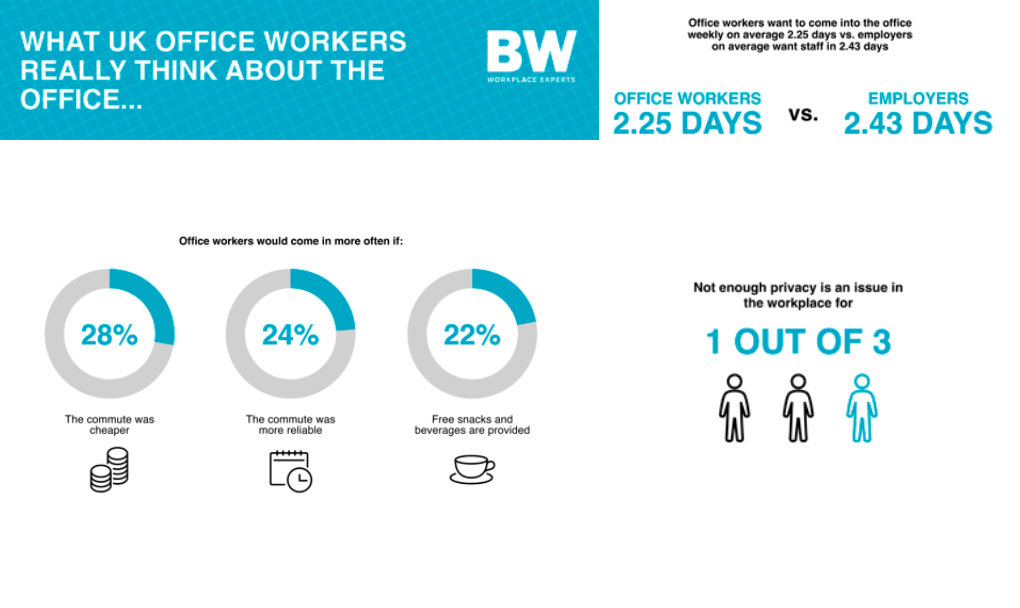New research from a survey of 2,000 UK office workers by BW: Workplace Experts reveals that poor quality open plan office layout and design could be falling out of favour, as one in three people (33%) have an issue with a lack of privacy in the office.
In fact, over a third (34%) ranked the most valuable spaces in the office as available meeting rooms, adequate amounts of breakout spaces, and social spaces, reflecting a desire to have more varied private and collaborative spaces. 27% said that they also value wellness spaces (eg exercise room, meditation room) and roughly one in 10 (11%) said access to outdoor space would influence them to go into the office more often.
Analysing the behaviours of office workers once they are in the workplace, the survey findings show that over half (52%) spend most of their time in the office working at their desk. In comparison, over a quarter (26%) said that most of their time is spent either talking to colleagues (10%), having in-person meetings (7%), working collaboratively (6%) or brainstorming (3%).
41% of UK office workers also said that they are more productive working at home. In comparison, just over a quarter of respondents (26%) say they are more productive at the office. Close to a third, at 32%, felt equally productive at home or at work.
Steve Elliott, CEO at BW: Workplace Experts, comments:
“More time spent working in the privacy of home during and since the pandemic could have left a lasting legacy on the workforce, as privacy and the perceived lack of it when at the office is now a key issue for a third. Open plan office design has been popular for some time now as a means to maximise office space, but if offices aren’t balanced with more private and independent working areas, businesses run the risk of causing issues for teams.
“The survey also highlights the value of break out spaces, meeting rooms, and social spaces – so why is most time spent behind a desk when in the office? Is it because that’s the only option? Rethinking office layout and design to help everyone at work get the most out of their day, no matter how many times they go in, should be the priority. This is important when you consider that 41% of workers feel more productive working at home than working from the office, which is a blow to employers convinced that productivity is enhanced in the office and critical to company success and the wider economy.”
When it comes to the frequency of being in the office, close to a quarter (24%) are required to attend the office five-days a week. One in five said they are required to come in two-days (20%), with the same amount (20%) responding three-days. Similarly, workers would prefer to come into the office two-days (22%) followed by three-days (20%).
Overall, just 10% of office workers don’t want to come in at all, but this increases with company size. Large (1000+) companies come out on top with over half (57%) not wanting to attend the office on a weekly basis, and close to half (47%) admitting they do not want to go into the office at all.
Getting to the office is also a barrier, with 28% sharing that they would come in more often if the commute was cheaper, and 24% said the same if their commute was more reliable. In a sign of the times, free snacks and beverages would influence 22% to go to the office.
Steve, continues:
“Returning to the office is on the rise, with a quarter already back full time and many working a hybrid approach, based on survey results. Instead of mandating a return to an office that doesn’t inspire productivity, businesses should take this as a challenge to help make office environments a more productive place to be, including a variety of spaces.
“It isn’t all down to the office itself though, employers also need to consider how inflation and the cost of living are impacting a return to the office, so much so that the survey shows cheaper travel and even free food would influence more people to go back to the office. With transport fare increases of 4.9 % now in effect across rail in England, this survey is a timely reminder of how the workforce is feeling squeezed.”


